Using word study activities in upper elementary is key to helping students become skilled readers. We want our students to transform into word watchers. This means when students see a word, they think about things like spelling, pronunciation, historical origin, and the connection to other words.
We can help our students to become word watchers by incorporating a variety of word study activities into our literacy block. When you are planning out your word study lessons and activities, you want to make sure that you are planning activities that cover four main word study concepts:
- Syllabication
- Affixes
- Roots
- Context Clues
While there are other word study concepts you can include in your lessons, word study activities that focus on these four concepts will help your students develop a strong foundation in word recognition and word understanding.
We know that both word recognition and word understanding are essential to becoming a skilled reader.
Let’s dig into some of the word study concepts and word study activities you can incorporate in your upper elementary classroom.
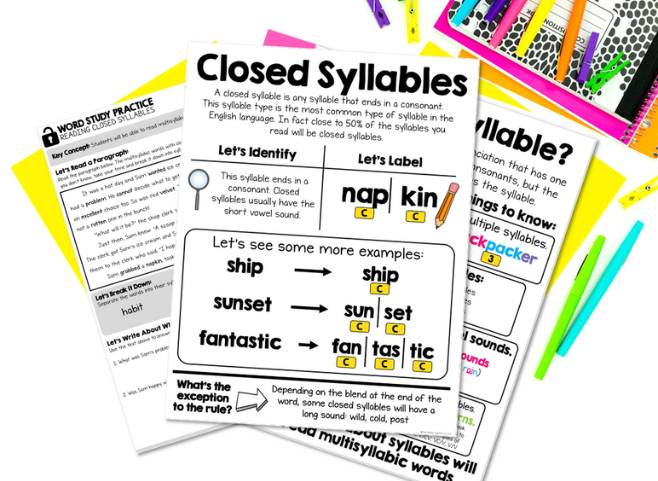
Key Word Study Concept #1: Syllabication
Syllabication is the act, process, or method of forming or dividing words into syllables. Teaching syllabication gives kids confidence to read multisyllabic words.
So often, we tell kids to “sound it out” or “break it down” when they see a word they don’t know. But, if our students don’t know the seven types of syllables or specific syllable division rules, those prompts aren’t always helpful.
When we explicitly teach syllabication, we are giving students tools they can use to break down and read big words. This is how teaching syllabication benefits your students:
- They will understand words can be separated into parts and syllables.
- They will understand each syllable has a vowel.
- They will understand the different sounds vowels can make (long, short, schwa).
- They can look for letter combinations that are consistent within the specific types of syllables.
What should I teach during syllabication lessons?
- What is a syllable?
- The sounds in syllables (short vowel, long vowels, and schwa)
- Syllable division rules
- The seven types of syllables
Check out my Types of Syllables resource that I developed for upper elementary teachers and students. It has scripted lesson plans, anchor charts, slides, and student pages. This word study resource will make it easy for you to teach syllables to your students!
Word Study Activity for Syllabication
To help students strengthen their understanding of syllabication, one word study activity you can have them do is a word sort. Students can sort words by the types of syllables or the number of syllables in a word.
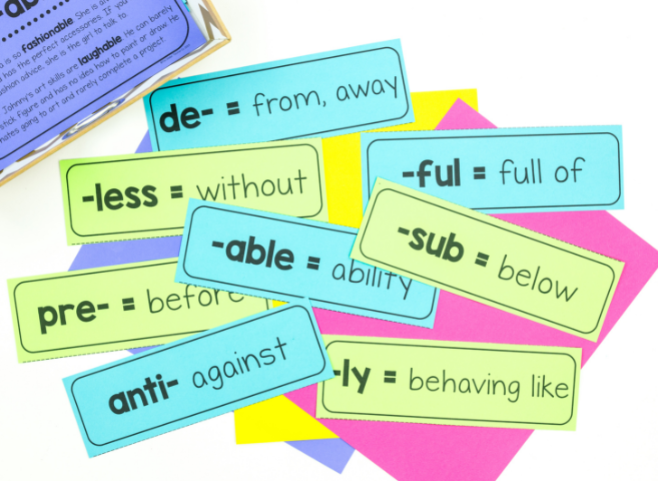
Key Word Study Concept #2: Affixes
An affix is a set of letters, generally added before or after a base word or a root word that modifies its meaning. A prefix is the term we use to describe a set of letters we add before a base or root word. A suffix is the term we use to describe a set of letters we add after a base or root word.
Affixes help students with both word recognition and word understanding. It is important for our students to recognize and understand the meaning of common affixes.
For example, if students know the letter combination -un means not or opposite of they can decipher new words they encounter with this prefix. If a student sees the word unbelievable they can determine the word means not believable.
Teaching affixes in-depth will help students understand the difference between inflectional endings and derivational endings.
- Inflectional endings are the suffixes that don’t change the part of speech. For example, the word student is a noun. If you add the suffix -s to it to make it plural, you get students, which is still a noun.
- Derivational endings are suffixes that can change the part of speech. For example, the word encourage is a verb, but if you add the suffix -ment to it you get encouragement, which is a noun.
By teaching students about affixes, we are giving them tools to help them recognize and understand the meaning of a word.
What should I teach during lessons on affixes?
- Common Prefixes
- Suffixes with inflectional endings
- Suffixes with derivational endings
Word Study Activity for Affixes
To help students strengthen their understanding of affixes, one word study activity you can have them do is word building. Students can build words with an assortment of prefixes and suffixes to help them better understand affixes and their purpose.
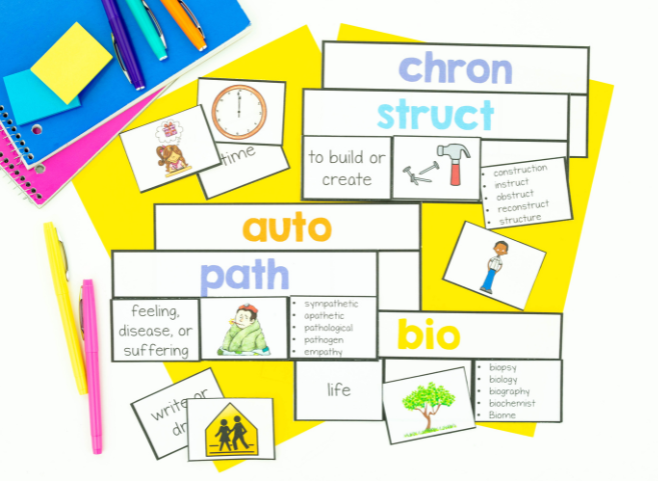
Key Word Study Concept #3 Roots
Let’s talk about roots! In Speech to Print by Louisa Moats, she defines roots as morphemes, usually of Latin origin, that cannot stand alone. Roots are used to form a family of words with related meanings.
A morpheme is the smallest unit of meaningful language. They can be of Latin or Greek origin. They are not words on their own.
When roots, or morphemes, are combined with other word parts, like prefixes or suffixes, they form words. Word study activities focused on roots help our students become confident and successful readers.
Why do we want to teach roots?
- About 60% of words in English are of Greek or Latin origin.
- If we can teach our students Greek and Latin roots, they will have the tools to figure out the meaning behind 60% of the words they encounter.
What should I teach during lessons on roots?
- What a root is.
- It’s helpful to teach a lesson about free vs. bound morphemes.
A free morpheme is a word that can stand on its own. For example, happy is a free morpheme. You do not need to combine it with any other word part to create a word. You can add prefixes and suffixes to it, but it doesn’t need them to be a complete word.
A bound morpheme is not a word but is still a unit of meaning. The root aud means to hear or listen. It is not a word on its own. Audible, auditory, audition, all of those words have the root aud. They all have some meaning connected to hearing or listening. If students understand the meaning of bound morphemes like aud, they can figure out the meaning of words with roots and other related words.
- Most common Latin roots
- Most common Greek roots
Word Study Activity for Roots
To help students build a stronger understanding of roots, have your students do word webs as a word study activity. Words webs are a great way to encourage your students to work with various root words and help them understand how words with the same root family are connected.
You can also check out my blog post on 5 Simple Ways to Teach Greek and Latin Root Words for word study activities for roots!
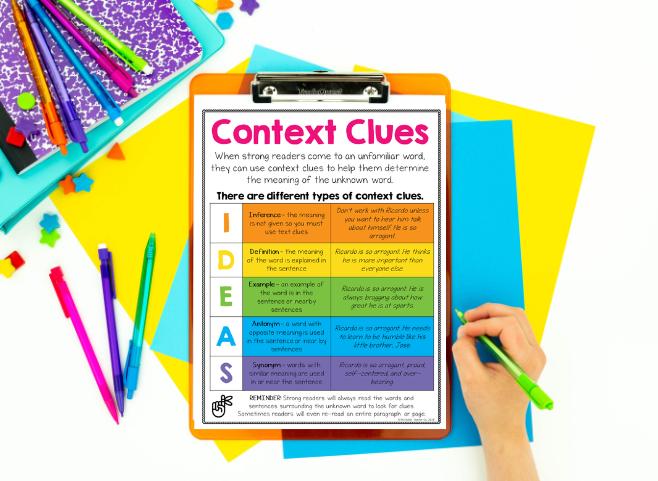
Key Word Study Concept #4: Context Clues
Context clues are defined as hints, or clues, found within a sentence, paragraph, or entire text that help a reader understand the meaning of new or unfamiliar words.
It is important to help our students understand context clues can be anywhere in a text, not just the sentence of the unfamiliar word.
We cannot teach our students every single word part, affix, root, and word study concept… there just isn’t enough time! So, we must give them tools and strategies they can use when they encounter new or unfamiliar words.
Explicitly teaching context clues is just one way we can support our students with word recognition and understanding. It is also a concept students will use in both word study and independent reading.
What should I teach during lessons on context clues?
- Teach the five types of context clues. To support you with this, check out Episode #41 of the podcast: The 5 Types of Context Clues to Teach Your Students.
- Teach students about parts of speech and the role words play within a sentence.
Word Study Activity for Context Clues
Word of the Week is one of our favorite word study activities for helping your students strengthen their understanding of context clues! This routine exposes students to wordy study concepts that encourage word recognition and understanding… plus it’s quick and easy!
Remember, you do not need to teach everything within each concept. Instead, build on each concept and review throughout the year. Teach, practice, apply… teach, practice, apply and teach, practice apply to help your students become natural word watchers!
Put it into practice…
If you are ready to take action and start implementing the ideas found in this blog post, here are three things you can do.
- Grab my free word of the week routine to help your students master using context clues.
- Listen to Episode #94 where I share even more about the four word study concepts every upper elementary teacher should be teaching.
- Come join us inside The Stellar Literacy Collective where you get access to a huge resource library that has word study lessons and activities to incorporate into your word study block.
Happy Teaching!
Grab Your FREE Gift!
Greek & Latin Root Word Reference Sheets
This root word reference sheet will help your students remember common Greek & Latin Root Words. The reference sheet includes the definition and examples of 40 common root words as well as picture cues! It also includes customizable spaces for students to add their own root words.
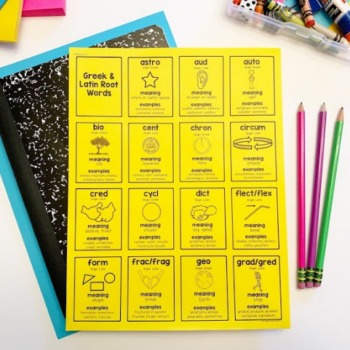


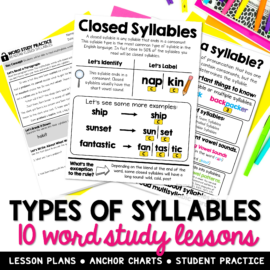
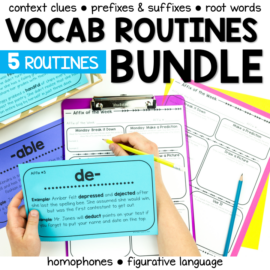
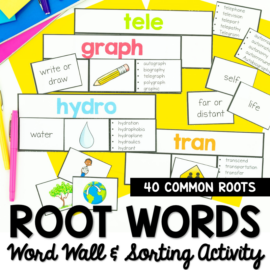
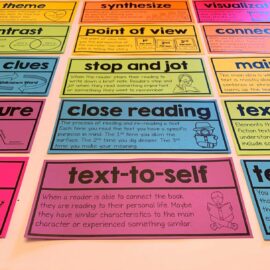
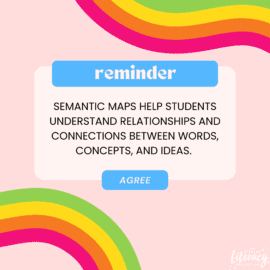
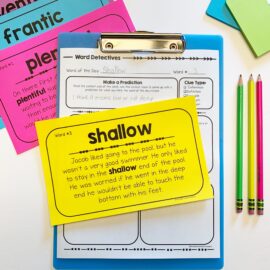









Leave a Comment
You must be logged in to post a comment.